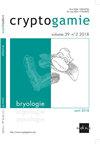黄貂草(鼠)前女友。和直流。)Brid。Moug交货。& Nestl。主要产于匈牙利,在有管理的森林中发现
IF 0.9
3区 生物学
Q4 PLANT SCIENCES
引用次数: 11
摘要
在过去的六年里,在匈牙利的野外研究中,发现了黄颡鱼(Buxbaumia viridis)的82个地点和2145个孢子体。前女友。和直流。)Brid。Moug交货。& Nestl。,即在截至2014年的普查中,普查地点增加41倍,孢子体数量增加143倍。当时已知的物种最近的发生(2个地点,4个林分,15个孢子体)都是在老林的腐木上发现的。然而,根据20世纪匈牙利植物标本的数据和中欧的新观测结果,我们的调查扩展到包括酸生、年轻和中年、管理和干扰森林的土壤,新种群主要出现在这些类型的栖息地,几乎完全在酸性土壤上。本文报道了新发现林分的种群大小、生境和基质偏好以及环境条件等方面的详细情况。如果这些不寻常的偏好(即管理的酸生性山毛榉林中的酸性土壤)不局限于匈牙利,那么在欧洲,这种列入生境指令附件二的Natura 2000物种的总种群规模可能被严重低估。本文章由计算机程序翻译,如有差异,请以英文原文为准。
Buxbaumia viridis (Moug. ex Lam. & DC.) Brid. ex Moug. & Nestl. in Hungary Predominantly Terricolous and Found in Managed Forests
ABSTRACT Field studies in Hungary during the last six years have led to the discovery of 82 localities and 2145 sporophytes of Buxbaumia viridis (Moug. ex Lam. & DC.) Brid. ex Moug. & Nestl., i.e. 41 times more localities and 143 times more sporophytes than reported in the previous census carried out up to 2014. The recent occurrences of the species known at that time (two localities with four stands and 15 sporophytes) were found exclusively on decaying wood in old growth forests. However, in the light of 20th century herbarium data from Hungary and new observations in Central Europe, our survey was extended to include the soil of acidophytic, young and middle-aged, managed and disturbed forests, and the new populations were mainly found in these types of habitats, almost exclusively on acidic soil. Details of population size, habitat and substrate preference, and environmental conditions at the newly found stands are reported in this paper. If these unusual preferences (i.e. acidic soil in managed, acidophytic beech forests) are not confined to Hungary, the total population size of this Natura 2000 species listed in annex II of the Habitat Directive might be severely underestimated in Europe.
求助全文
通过发布文献求助,成功后即可免费获取论文全文。
去求助
来源期刊

Cryptogamie Bryologie
生物-植物科学
CiteScore
2.10
自引率
25.00%
发文量
12
审稿时长
3 months
期刊介绍:
Cryptogamie is a fully electronic journal, with a continuous
publication stream, devoted to a wide diversity of cryptogamic
topics, mainly in the taxonomic-phylogenetic field.
Cryptogamie, Bryologie accepts articles on systematics as
well as ecology and evolution of all of bryophytes.
Thematic issues may also be published under the responsibility of a guest editor.
 求助内容:
求助内容: 应助结果提醒方式:
应助结果提醒方式:


